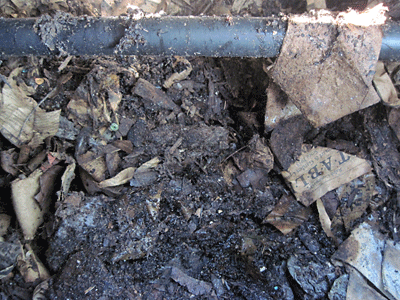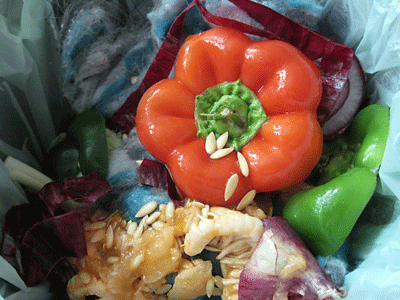We eat a lot of produce in our house and because of this we also create a lot of waste. It was starting to get on my nerves, so I asked my husband if he would buy me a compost bin. He looked at me like I was crazy, but told me to go for it, so I did.
I wanted something that was easy to use and as rodent-free as possible. I wanted to get involved with composting, but I also knew that if I had to aerate a compost bin with pitchfork, I’d never do it. So after some research, I went with a Tumbling Batch Composter from Gardener’s Supply Company. I liked the idea that I could just give it a spin and it would do its job; I could pretend that I was on Wheel of Fortune every day – how fun!
Anyway, I also bought their Stainless Steel Compost Pail and BioBags™ for indoor use because I knew I wouldn’t want to run out to the yard every time I had some apple peels to toss! And, since I didn’t want the house to smell like rotten produce all of the time, I wanted something smell-proof, and this pail does the job. I can honestly say that I can’t smell a thing when the lid is closed!
Plus, the BioBags™ are really cool because they are made of 100% biodegradable cornstarch, so you can just throw the entire bag out into the main composter once it’s full. But, beware: if you leave the BioBags™ in your indoor pail for too long, they’ll start to disintegrate and that’ll leave you with one stinky mess to clean up (I’ve done it twice now!).
I’m surprised to say that composting is not as difficult as I thought it might be, but it does require your attention. The one thing I’ve learned is that if you do not heed the carbon-to-nitrogen ratio, you will end up with either:
a.) a too dry, do-nothing pile, or
b.) a too wet, stinking mess!
I only know this due to trial-and-error. At first, I was firing way too much green stuff in there (aka: nitrogen) and not enough brown stuff (aka: carbon). Every time I opened up the compost tumbler, I was accosted by swarms of black flies and a knock-you-off-your-feet stench. It gave me the willies so bad, that I almost tossed in the towel. But, I didn’t want to give up so easily, so I went back online to find some other sources of carbon to balance things out.
Lucky for me, I found the compost section on the Environmental Protection Agency’s web site. It listed all of these really cool things that I could compost – some of them I knew about, but others, like dryer lint, egg shells and fireplace ashes, were brand new to me!
Look at all of the ordinary things you can compost:
|
NITROGEN / GREEN |
CARBON / BROWN |
EXTRA NUTRIENTS |
|
Grass clippings |
Leaves, dry |
Egg shells, washed = calcium |
|
Manure from herbivores (vegetarians) (i.e. horse or cow manure, rabbit droppings, etc.) |
Newspaper, shredded |
Fireplace ashes (real wood only; not starter logs) = increases the alkalinity and salinity of the soil |
|
Fruit |
Coffee filters, tea bags |
|
|
Vegetables |
Dryer lint |
|
|
Coffee grinds |
Cardboard rolls (i.e. paper towels) |
|
|
Hair, human or pet |
Clean paper shredded |
|
|
Houseplants, non-diseased |
Peanut shells |
|
|
Pumpkin shells |
Pine needles |
|
|
Blood meal |
Straw |
|
Composting has given me a new sense of pride in our home. Now, instead of firing all of our left-over, uneaten fruit and veggies into the garbage pail, I’m actually using them. And, in return, they will make glorious compost for my gardens next year. How cool is that?
So if you’re thinking about composting in the near future, I say, “Go for it!” It really does empower you, and it’s not all that involved.
For additional, and more detailed, information about composting, check out the following web sites:
Environmental Protection Agency
Florida’s Online Composting Center
Morganic's Organic Gardening Site





Thanks Dre! If I think about it too much, then I start to panick. I find that it’s pretty easy as long as you remember that you need a LOT more carbon than nitrogen. 🙂
Denine, great tips on composting. My father in law tried to explain the balancing but I find your list and references more helpful. If I ever get to putting in a garden, I want to compost.